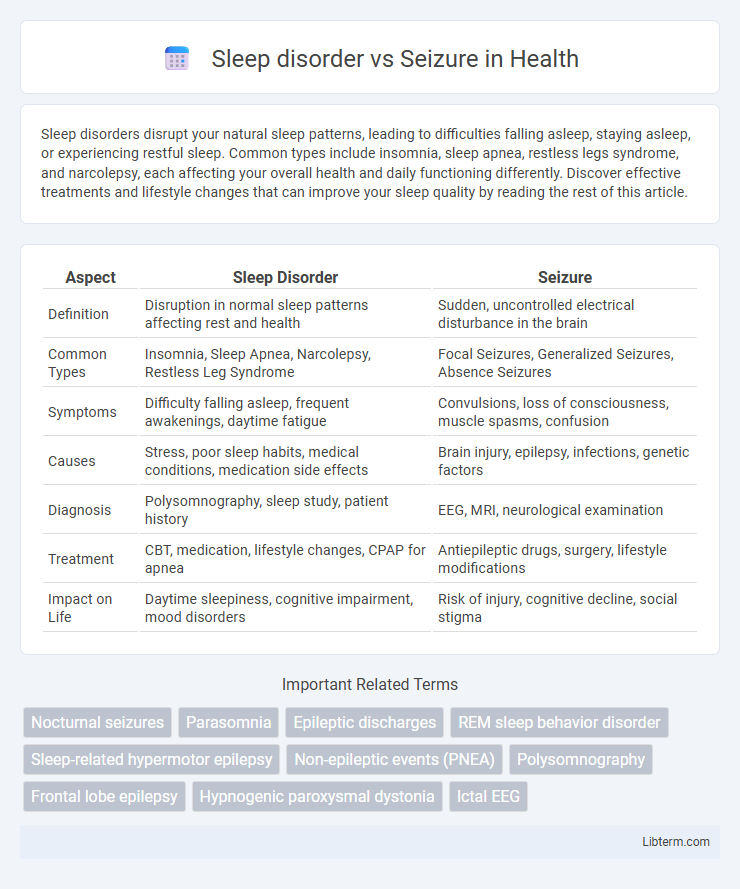Sleep disorders disrupt your natural sleep patterns, leading to difficulties falling asleep, staying asleep, or experiencing restful sleep. Common types include insomnia, sleep apnea, restless legs syndrome, and narcolepsy, each affecting your overall health and daily functioning differently. Discover effective treatments and lifestyle changes that can improve your sleep quality by reading the rest of this article.
Table of Comparison
| Aspect | Sleep Disorder | Seizure |
|---|---|---|
| Definition | Disruption in normal sleep patterns affecting rest and health | Sudden, uncontrolled electrical disturbance in the brain |
| Common Types | Insomnia, Sleep Apnea, Narcolepsy, Restless Leg Syndrome | Focal Seizures, Generalized Seizures, Absence Seizures |
| Symptoms | Difficulty falling asleep, frequent awakenings, daytime fatigue | Convulsions, loss of consciousness, muscle spasms, confusion |
| Causes | Stress, poor sleep habits, medical conditions, medication side effects | Brain injury, epilepsy, infections, genetic factors |
| Diagnosis | Polysomnography, sleep study, patient history | EEG, MRI, neurological examination |
| Treatment | CBT, medication, lifestyle changes, CPAP for apnea | Antiepileptic drugs, surgery, lifestyle modifications |
| Impact on Life | Daytime sleepiness, cognitive impairment, mood disorders | Risk of injury, cognitive decline, social stigma |
Understanding Sleep Disorders: An Overview
Sleep disorders encompass a range of conditions like insomnia, sleep apnea, and narcolepsy, characterized by disrupted sleep patterns and impaired daytime functioning. Seizures, triggered by abnormal electrical brain activity, can mimic certain sleep disturbances but involve neurological episodes often diagnosed through EEG monitoring. Distinguishing between sleep disorders and seizures is crucial for targeted treatment, as misdiagnosis can lead to ineffective therapy and prolonged health complications.
What Are Seizures? Key Definitions
Seizures are sudden, uncontrolled electrical disturbances in the brain that can cause changes in behavior, movements, feelings, or levels of consciousness. Unlike sleep disorders, which primarily affect sleep patterns and quality, seizures involve abnormal neuronal activity that may lead to convulsions, sensory disturbances, or loss of awareness. Understanding seizures requires distinguishing between types such as focal seizures, which affect specific brain areas, and generalized seizures, which impact the entire brain.
Common Symptoms: Sleep Disorder vs Seizure
Common symptoms of sleep disorders include excessive daytime sleepiness, difficulty falling or staying asleep, and unrefreshing sleep, whereas seizures often manifest as sudden, uncontrolled movements, loss of awareness, and convulsions. Both conditions can cause confusion and fatigue, but seizures may also lead to temporary paralysis or strange sensations. Differentiating between sleep disorders and seizures is crucial, as overlapping symptoms like altered consciousness require distinct diagnostic and treatment approaches.
Causes and Risk Factors: A Comparative Analysis
Sleep disorders and seizures exhibit distinct causes and risk factors rooted in neurological and physiological differences. Sleep disorders often arise from factors such as stress, irregular sleep schedules, and underlying medical conditions like sleep apnea or restless leg syndrome. Seizures typically result from abnormal electrical activity in the brain, triggered by epilepsy, brain trauma, infections, or genetic predispositions.
Diagnostic Tools for Sleep Disorders and Seizures
Diagnostic tools for sleep disorders primarily include polysomnography, which monitors brain waves, oxygen levels, heart rate, and muscle activity during sleep to identify conditions like sleep apnea and narcolepsy. EEG (electroencephalogram) is the key diagnostic tool for seizures, detecting abnormal electrical activity in the brain that characterizes epilepsy and related disorders. Video-EEG monitoring combines both methods to differentiate between nocturnal seizures and parasomnias, ensuring accurate diagnosis and treatment planning.
How Sleep Disorders Can Mimic Seizures
Sleep disorders such as parasomnias and REM sleep behavior disorder often produce symptoms that closely resemble seizures, including sudden jerking movements, twitching, and unusual behaviors during sleep. These manifestations can complicate diagnosis as nocturnal seizures share similar clinical presentations, making differentiation dependent on detailed sleep studies or EEG monitoring. Accurate identification is crucial for effective treatment since misdiagnosis can lead to inappropriate seizure medications or untreated sleep disorders.
Differences in Treatment Approaches
Treatment approaches for sleep disorders primarily involve behavioral therapies, sleep hygiene practices, and medications like melatonin or sedative-hypnotics, targeting the restoration of normal sleep patterns. Seizure management relies heavily on antiepileptic drugs (AEDs) such as carbamazepine or valproate to control abnormal electrical brain activity, with surgery or vagus nerve stimulation reserved for refractory cases. Unlike seizure treatment, sleep disorder therapies emphasize regulating circadian rhythms and improving sleep quality rather than suppressing neural hyperexcitability.
Impact on Daily Life: Sleep Disorder vs Seizure
Sleep disorders severely impair daily functioning by causing chronic fatigue, reduced concentration, and mood disturbances, which diminish productivity and social interactions. Seizures unpredictably disrupt routine activities, increasing the risk of injury and limiting independence due to potential cognitive impairments and safety concerns. Both conditions markedly reduce quality of life, but seizures pose higher immediate physical risks, whereas sleep disorders cause prolonged neurocognitive decline and emotional strain.
When to Seek Medical Help
Seek medical help immediately if seizures occur frequently, last longer than five minutes, or cause loss of consciousness. Persistent sleep disorders accompanied by sudden jerking movements, confusion, or unusual behaviors during sleep warrant professional evaluation to rule out seizure activity. Early diagnosis and treatment by a neurologist or sleep specialist can prevent complications and improve quality of life.
Prevention and Management Strategies
Effective prevention and management of sleep disorders and seizures involve tailored approaches such as maintaining regular sleep schedules, minimizing exposure to seizure triggers, and adhering to prescribed medications like antiepileptics or sleep aids. Behavioral interventions including cognitive-behavioral therapy for insomnia and stress reduction techniques can improve overall neurological health and reduce frequency of episodes. Regular monitoring by healthcare professionals and lifestyle modifications such as avoiding alcohol and ensuring adequate sleep hygiene are critical for minimizing risks and enhancing patient outcomes.
Sleep disorder Infographic

 libterm.com
libterm.com